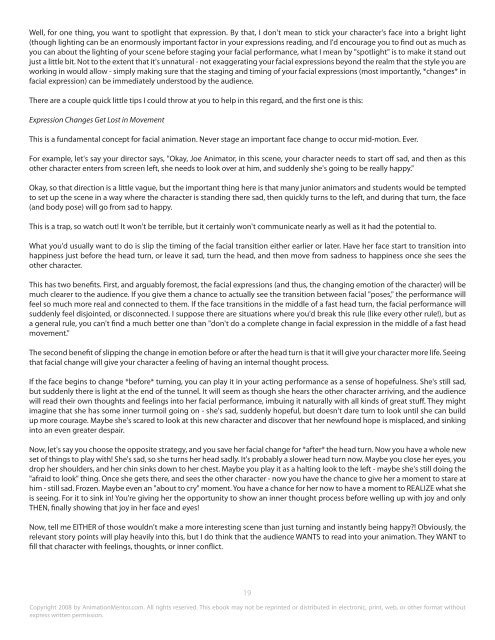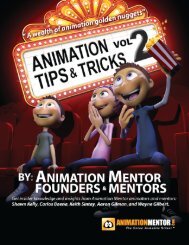Animation Tips & Tricks, Volume I - Animation Mentor
Animation Tips & Tricks, Volume I - Animation Mentor
Animation Tips & Tricks, Volume I - Animation Mentor
You also want an ePaper? Increase the reach of your titles
YUMPU automatically turns print PDFs into web optimized ePapers that Google loves.
Well, for one thing, you want to spotlight that expression. By that, I don't mean to stick your character's face into a bright light(though lighting can be an enormously important factor in your expressions reading, and I'd encourage you to find out as much asyou can about the lighting of your scene before staging your facial performance, what I mean by "spotlight" is to make it stand outjust a little bit. Not to the extent that it's unnatural - not exaggerating your facial expressions beyond the realm that the style you areworking in would allow - simply making sure that the staging and timing of your facial expressions (most importantly, *changes* infacial expression) can be immediately understood by the audience.There are a couple quick little tips I could throw at you to help in this regard, and the first one is this:Expression Changes Get Lost in MovementThis is a fundamental concept for facial animation. Never stage an important face change to occur mid-motion. Ever.For example, let's say your director says, "Okay, Joe Animator, in this scene, your character needs to start off sad, and then as thisother character enters from screen left, she needs to look over at him, and suddenly she's going to be really happy."Okay, so that direction is a little vague, but the important thing here is that many junior animators and students would be temptedto set up the scene in a way where the character is standing there sad, then quickly turns to the left, and during that turn, the face(and body pose) will go from sad to happy.This is a trap, so watch out! It won't be terrible, but it certainly won't communicate nearly as well as it had the potential to.What you'd usually want to do is slip the timing of the facial transition either earlier or later. Have her face start to transition intohappiness just before the head turn, or leave it sad, turn the head, and then move from sadness to happiness once she sees theother character.This has two benefits. First, and arguably foremost, the facial expressions (and thus, the changing emotion of the character) will bemuch clearer to the audience. If you give them a chance to actually see the transition between facial "poses," the performance willfeel so much more real and connected to them. If the face transitions in the middle of a fast head turn, the facial performance willsuddenly feel disjointed, or disconnected. I suppose there are situations where you'd break this rule (like every other rule!), but asa general rule, you can't find a much better one than "don't do a complete change in facial expression in the middle of a fast headmovement."The second benefit of slipping the change in emotion before or after the head turn is that it will give your character more life. Seeingthat facial change will give your character a feeling of having an internal thought process.If the face begins to change *before* turning, you can play it in your acting performance as a sense of hopefulness. She's still sad,but suddenly there is light at the end of the tunnel. It will seem as though she hears the other character arriving, and the audiencewill read their own thoughts and feelings into her facial performance, imbuing it naturally with all kinds of great stuff. They mightimagine that she has some inner turmoil going on - she's sad, suddenly hopeful, but doesn't dare turn to look until she can buildup more courage. Maybe she's scared to look at this new character and discover that her newfound hope is misplaced, and sinkinginto an even greater despair.Now, let's say you choose the opposite strategy, and you save her facial change for *after* the head turn. Now you have a whole newset of things to play with! She's sad, so she turns her head sadly. It's probably a slower head turn now. Maybe you close her eyes, youdrop her shoulders, and her chin sinks down to her chest. Maybe you play it as a halting look to the left - maybe she's still doing the"afraid to look" thing. Once she gets there, and sees the other character - now you have the chance to give her a moment to stare athim - still sad. Frozen. Maybe even an "about to cry" moment. You have a chance for her now to have a moment to REALIZE what sheis seeing. For it to sink in! You're giving her the opportunity to show an inner thought process before welling up with joy and onlyTHEN, finally showing that joy in her face and eyes!Now, tell me EITHER of those wouldn't make a more interesting scene than just turning and instantly being happy?! Obviously, therelevant story points will play heavily into this, but I do think that the audience WANTS to read into your animation. They WANT tofill that character with feelings, thoughts, or inner conflict.19Copyright 2008 by <strong>Animation</strong><strong>Mentor</strong>.com. All rights reserved. This ebook may not be reprinted or distributed in electronic, print, web, or other format withoutexpress written permission.








